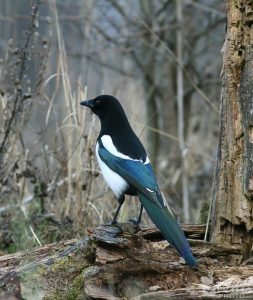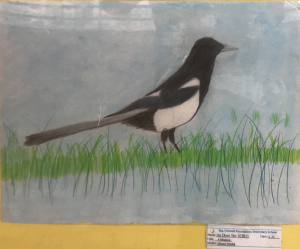| Common Name | (in English) Common Magpie, Eurasian magpie |
| (in Chinese) 喜鵲 | |
| Scientific Name | (in Latin) Pica pica |
| Peculiar characteristics / external features: | The adult male of the nominate subspecies, P. p. pica, is 44–46 cm (17–18 in) in length, of which more than half is the tail. The wingspan is 52–62 cm (20–24 in). The head, neck and breast are glossy black with a metallic green and violet sheen; the belly and scapulars (shoulder feathers) are pure white; the wings are black glossed with green or purple, and the primaries have white inner webs, conspicuous when the wing is open. The graduated tail is black, glossed with green and reddish purple. The legs and bill are black; the iris is dark brown. The plumage of the sexes is similar but females are slightly smaller. The tail feathers of both sexes are quite long, about 12-28 cm long. |
| Distributions: | The range of the magpie extends across temperate Eurasia from Spain and Ireland in the west to the Kamchatka Peninsula and Taiwan in the east. There are also populations in northwest Africa and on Mediterranean islands. The species has been introduced in Japan on the island of Kyushu.
The preferred habit is open countryside with scattered trees and magpies are normally absent from treeless areas and dense forests. They sometimes breed at high densities in suburban settings such as parks and gardens. They can often be found close to the centre of cities |
| Habits: | |
| Dietary | The magpie is omnivorous, eating young birds and eggs, small mammals, insects, scraps and carrion, acorns, grain, and other vegetable substances. |
| Reproductive (Solitary/Social/Territorial, Courtship Behavior, Taking care of youngs, etc) | Some magpies breed after their first year while others remain in the non-breeding flocks and first breed in their second year. They are monogamous and the pairs often remain together from one breeding season to the next. They generally occupy the same territory on successive years.
Mating takes place in spring. In the courtship display males rapidly raise and depress their head feathers, uplift, open and close their tails like fans, and call in soft tones quite distinct from their usual chatter. The loose feathers of the flanks are brought over the primaries, and the shoulder patch is spread so the white is conspicuous, presumably to attract females. Short buoyant flights and chases follow. Magpies prefer tall trees for their bulky nest, firmly attaching them to a central fork in the upper branches. A framework of the sticks is cemented with earth and clay, and a lining of the same is covered with fine roots. Above is a stout though loosely built dome of prickly branches with a single well-concealed entrance. These huge nests are conspicuous when the leaves fall. Where trees are scarce, though even in well-wooded country, nests are at times built in bushes and hedgerows. |
| Whatever appropriate | |
| Interesting Fact: | During the winter the magpie’s diet is largely vegetarian, and in the summer predominately ground invertebrates. Only during the spring, when feeding its young, does it become a major predator, raiding the nests of songbirds for eggs and young. |
References:
- https://ww2.rspb.org.uk/community/wildlife/f/13609/t/8983.aspx
- http://www.oiseaux-birds.com/card-eurasian-magpie.html
- https://www.britannica.com/story/eurasian-magpie-a-true-bird-brain
Voice of Common Magpie:
https://www.british-birdsongs.uk/common-magpie/
Video:




